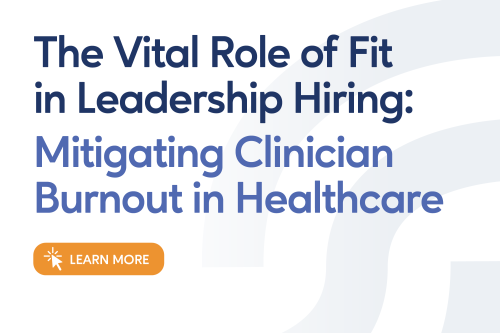In the vast and intricate healthcare landscape, where the well-being of both patients and professionals hangs in the balance, the significance of effective leadership cannot be overstated. Healthcare leaders not only steer the course of institutions but also profoundly influence the experiences and outcomes of clinicians on the frontline. Yet, amidst the persistent challenge of clinician burnout, the need to find the right fit in leadership roles has emerged as a critical imperative.
Understanding Clinician Burnout
Clinician burnout, characterized by emotional exhaustion, depersonalization, and a diminished sense of personal accomplishment, has reached alarming levels in recent years. The intricate web of stressors contributing to burnout includes heavy workloads, administrative burdens, and a sense of disconnection from the core mission of healthcare—caring for patients. In this landscape, the role of leadership becomes pivotal, as they are not just managers but architects of the organizational culture that shapes clinician well-being.
However, leaders are insufficient for addressing clinician burnout; what makes a difference is the alignment between their values, vision, and the organization's ethos. This alignment, often referred to as "fit," is multifaceted and encompasses cultural, strategic, and interpersonal dimensions.
Why Cultural Fit Matters
Firstly, cultural fit entails shared values, beliefs, and norms between leaders and the organization. In healthcare, where compassion, integrity, and patient-centered care are paramount, leaders must embody these principles. Misalignment in cultural fit can lead to discord, where leaders may prioritize financial gains or bureaucratic processes over the well-being of employees, exacerbating clinician burnout.
Secondly, strategic fit involves alignment between the leader's vision and the organizational goals. Effective leaders not only navigate the current challenges but also inspire a collective journey towards a better future. A leader out of sync with the organizational mission may introduce conflicting agendas, leading to confusion and disillusionment, therefore feeding the flame of clinician burnout.
Lastly, interpersonal fit pertains to the leader's ability to foster meaningful relationships and trust within the team. In healthcare, where collaboration and communication are vital for delivering quality care, leaders must possess empathy, listening skills, and emotional intelligence. A leader lacking in interpersonal fit may engender resentment or disengagement among staff, further fueling clinician burnout.
The consequences of overlooking fit in leadership hiring can be profound, permeating through the fabric of healthcare organizations. Incompatible leaders may perpetuate toxic cultures, where fear, mistrust, and apathy thrive, driving talented staff away and compromising patient care. Moreover, the financial costs of clinician burnout, including decreased productivity, increased turnover, and medical errors, impose a heavy toll on institutions.
Conversely, prioritizing fit in leadership hiring can yield manifold benefits. Leaders who resonate with the organization's values inspire commitment and resilience among clinicians, fostering a culture of support and collaboration. By championing initiatives that promote work-life balance, streamline workflows, and prioritize employee well-being, these leaders become catalysts for mitigating clinician burnout and cultivating thriving healthcare ecosystems.
So, how can healthcare organizations ensure they find the right fit in leadership roles to avoid the progression of clinician burnout? It begins with a comprehensive approach to recruitment and selection, where qualitative assessments of fit are integrated into the process alongside traditional metrics of competency and experience. Structured interviews, behavioral assessments, and immersive experiences such as shadowing, or simulation exercises can provide valuable insights into a candidate's fit with the organization's culture, vision, and team dynamics.
Furthermore, ongoing support and development for leaders are essential to reinforce and deepen their alignment with the organization over time. Mentoring programs, leadership coaching, and feedback mechanisms facilitate continuous growth and adaptation, ensuring leaders remain attuned to the evolving needs of clinicians and the broader healthcare landscape.
In conclusion, the quest for mitigating clinician burnout in healthcare necessitates a change in basic assumptions in how we approach leadership hiring. Beyond resumes and credentials, the concept of fit emerges as a linchpin in building resilient, compassionate, and effective leadership that fosters clinician well-being. Healthcare organizations can sow the seeds of transformation by investing in finding the right fit and cultivating environments where clinicians and patients thrive.
SimiTree specializes in interim management, executive placement and management recruiting for the home health, hospice, and behavioral health industries. To learn more about how we can help you address clinician burnout, visit this page.

